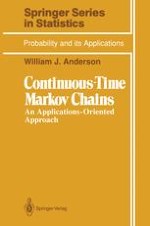1991 | OriginalPaper | Buchkapitel
Existence and Uniqueness of Q-Functions
verfasst von : William J. Anderson
Erschienen in: Continuous-Time Markov Chains
Verlag: Springer New York
Enthalten in: Professional Book Archive
Aktivieren Sie unsere intelligente Suche, um passende Fachinhalte oder Patente zu finden.
Wählen Sie Textabschnitte aus um mit Künstlicher Intelligenz passenden Patente zu finden. powered by
Markieren Sie Textabschnitte, um KI-gestützt weitere passende Inhalte zu finden. powered by
Suppose that $$\left\{ {{X_n},n = 0,1,...} \right\}$$ is a discrete time Markov chain with discrete state space E and stationary transition probabilities. Then the reader is well aware that such a stochastic process is uniquely determined by the one-step transition matrix P whose i,jth component is $${p_{ij = }}\Pr \left\{ {{X_{n + 1}} = j\left| {{X_n} = i} \right.} \right\},$$, and an initial distribution vector p, whose ith component is $${p_i} = \Pr \left\{ {{X_0} = i} \right\}.$$. Every probability involving the random variables of this chain can be determined from the finite-dimensional distributions $$\Pr \left\{ {{X_{{n_1}}} = {i_1},{X_{{n_2}}} = {i_2},...,{X_{{n_k}}} = {i_k}} \right\}$$, and the latter can be expressed in the form $$\sum\limits_i p iPi{i_1}\left( {{n_1}} \right)P{i_1}{i_2}\left( {{n_2} - {n_1}} \right)...{P_{{i_{k - 1}}}}_{{i_k}}\left( {{n_k} - {n_{k - 1}}} \right),$$, where P ij (n) is the i,jth element of the n-step transition matrix Pn, which is the nth power of the one-step transition matrix P. Furthermore, the one-step transition probabilities P ij have very obvious meaning in terms of the process being modeled by the Markov chain, and are easily estimated from observations of the process.
